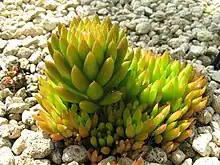Orostachys japonica
Orostachys japonica (Japanese:爪蓮華、昭和、秀女)also known as rock pine is a species of flowering plant in the family Crassulaceae.[1] Native to East Asia. Its main habitat is on the surface of mountain rocks in Korea, Japan and China.[2][3]
| Orostachys japonica | |
|---|---|
 | |
| Scientific classification | |
| Kingdom: | Plantae |
| Clade: | Tracheophytes |
| Clade: | Angiosperms |
| Clade: | Eudicots |
| Order: | Saxifragales |
| Family: | Crassulaceae |
| Genus: | Orostachys |
| Species: | O. japonica |
| Binomial name | |
| Orostachys japonica | |
| Synonyms[1] | |
|
Cotyledon japonica Maxim. | |
Ecology
Orostachys japonica is a biennial/perennial plant growing to 10 centimetres (3.9 in). It is in flower from September to October. The flowers are hermaphrodite. The rosette leaves shape like a spatula.[3]
- Suitable for: light sandy and loamy soils, prefers well-drained soil and can grow in nutritionally poor soil.
- Suitable pH: acid, neutral and basic alkaline soils.
Because of its growing shape which resembles a pine tree's cone, and its habit of growing on mountain rocks, it is also called rock pine.[2] It grows well in a sunny or semi-shaded(light woodland) location with a well-drained and moist soil that is low in nutrients. Its flowers bloom from September to October. The flowers are white and each flower has 5 conical petals. The flower lacks a peduncle. Its calyx is divided into 5 parts. When the flowers bloom and produce seeds, it dries out.

Medicinal uses
The leaves and stems contain several medically active constituents including fatty acid esters, Friedelin and flavonoids.[2] They are antispasmodic and cytotoxic. It has anti-cancer effects in vitro. In Korea, they are used in the treatment of cancer, gingivitis, coagulation and metritis.[2]
References
- "Orostachys japonica (Maxim.) A.Berger". Plants of the World Online. The Trustees of the Royal Botanic Gardens, Kew. n.d. Retrieved August 22, 2020.
- Medicinal Plants In the Republic of Korea. Natural Products research institute (Seoul National University). p. 187.
- "Flora of China on-line". FOC Vol.8 241000249. Flora of China on-line. Archived from the original on 15 October 2013. Retrieved 8 October 2013.